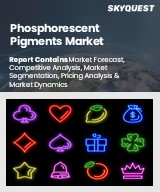
세계의 축광안료 시장 규모는 2023년에 23억 달러로 평가되며, 2024년 24억 달러에서 2032년에는 34억 2,000만 달러로 성장하며, 예측 기간(2025-2032년)의 CAGR은 4.5%로 성장할 전망입니다.
세계 축광 안료 시장은 건설, 안전, 소비재, 포장 등 다양한 분야 수요 증가로 인해 크게 성장할 것으로 전망됩니다. 건축 및 안전 분야에서는 저조도에서의 시인성을 높여 출구 표지판이나 위험 표지판 등에 활용되고 있습니다. 장난감, 시계 등 소비재에 어둠 속에서 빛을 내는 기능이 탑재되고 있는 것이 시장 침투를 더욱 촉진하고 있습니다. 또한 발광 포장 및 섬유의 혁신적인 용도가 등장하여 축광 안료의 적용 범위가 넓어지고 있음을 보여줍니다. 그러나 높은 생산 비용, 제한된 빛의 가용성, 미개발 지역에 대한 인식 부족 등의 문제가 시장 확대에 걸림돌이 될 수 있습니다. 엄격한 규제와 특정 지역에서의 접근성 제한도 축광 안료 시장의 잠재력에 큰 제약을 가져옵니다.
Global Phosphorescent Pigments Market size was valued at USD 2.3 billion in 2023 and is poised to grow from USD 2.4 billion in 2024 to USD 3.42 billion by 2032, growing at a CAGR of 4.5% during the forecast period (2025-2032).
The global phosphorescent pigments market is poised for significant growth, driven by heightened demand across various sectors, particularly construction, safety, consumer goods, and packaging. In construction and safety, these pigments enhance visibility in low-light situations, being utilized in exit signs and hazard markings. The growing integration of glow-in-the-dark features in consumer products, such as toys and watches, is further propelling market penetration. Additionally, innovative applications in luminous packaging and textiles are emerging, indicating a broadening scope for phosphorescent pigments. However, challenges like high production costs, limited availability of light, and a lack of awareness in underdeveloped regions may hinder market expansion. Stringent regulations and restricted availability in certain regions also pose significant constraints to the phosphorescent pigments market's potential.
Top-down and bottom-up approaches were used to estimate and validate the size of the Global Phosphorescent Pigments market and to estimate the size of various other dependent submarkets. The research methodology used to estimate the market size includes the following details: The key players in the market were identified through secondary research, and their market shares in the respective regions were determined through primary and secondary research. This entire procedure includes the study of the annual and financial reports of the top market players and extensive interviews for key insights from industry leaders such as CEOs, VPs, directors, and marketing executives. All percentage shares split, and breakdowns were determined using secondary sources and verified through Primary sources. All possible parameters that affect the markets covered in this research study have been accounted for, viewed in extensive detail, verified through primary research, and analyzed to get the final quantitative and qualitative data.
Global Phosphorescent Pigments Market Segments Analysis
Global Phosphorescent Pigments Market is segmented by Type, Application and region. Based on Type, the market is segmented into Strontium Aluminate, Zinc Sulfide, Calcium Sulfide and Other Phosphorescent Pigments. Based on Application, the market is segmented into Construction Materials, Paints and Coating, Plastics, Textiles and Printed Inks. Based on region, the market is segmented into North America, Europe, Asia Pacific, Latin America and Middle East & Africa.
Driver of the Global Phosphorescent Pigments Market
The increasing demand for dependable visibility solutions during power outages, emergencies, and nighttime scenarios has led to a heightened adoption of phosphorescent pigments in safety and exit signage. These pigments provide enduring illumination without the need for electricity, making them ideally suited for use in stairwells, hallways, fire exits, and hazard indicators. Moreover, their compliance with safety regulations in various building and infrastructure applications further fuels global demand. As safety standards become more stringent and the need for effective emergency lighting solutions grows, the market for phosphorescent pigments continues to expand, emphasizing their importance in enhancing public safety.
Restraints in the Global Phosphorescent Pigments Market
The use of zinc sulfide-based pigments as cost-effective alternatives presents certain challenges, including diminished glow duration and lower luminosity when compared to more advanced materials. These drawbacks limit their effectiveness in essential areas such as emergency signage and industrial use, where reliable visibility is paramount. Consequently, these pigments often necessitate more frequent re-application or replacement, which diminishes their appeal for safety solutions designed for extensive use over extended periods. This inherent limitation could hinder the overall growth and adoption of phosphorescent pigments in markets that prioritize performance and longevity.
Market Trends of the Global Phosphorescent Pigments Market
The Global Phosphorescent Pigments market is witnessing a significant shift driven by an increasing focus on energy efficiency and sustainability. As industries seek environmentally friendly alternatives, the demand for phosphorescent pigments has surged, particularly in safety and construction applications. These innovative pigments luminesce without electricity, enabling reduced reliance on powered lighting for exits, signage, and footpaths, thereby promoting energy conservation. The growing emphasis on green-building certifications and sustainability standards globally is further propelling this trend, as consumers and companies alike prioritize eco-conscious solutions that align with their values and operational goals, fostering a robust market for phosphorescent pigments.